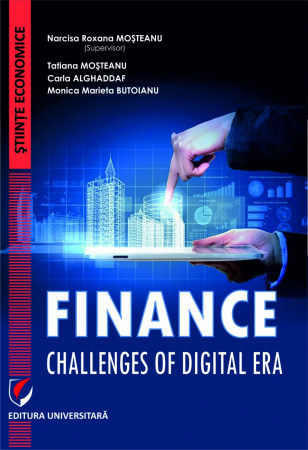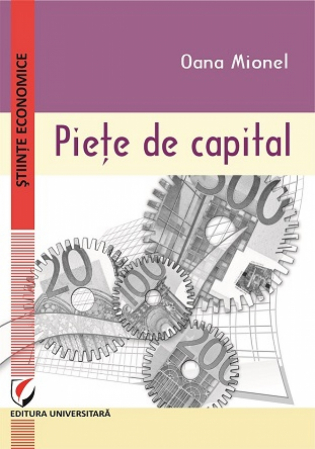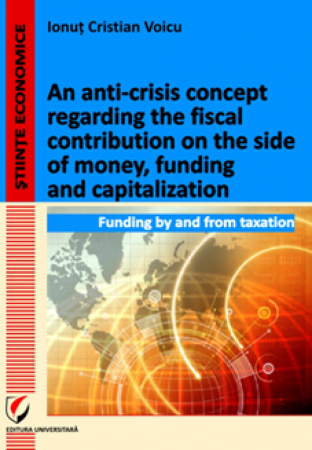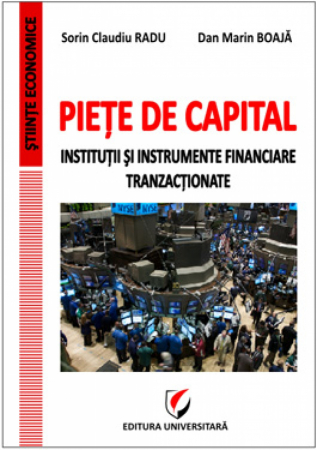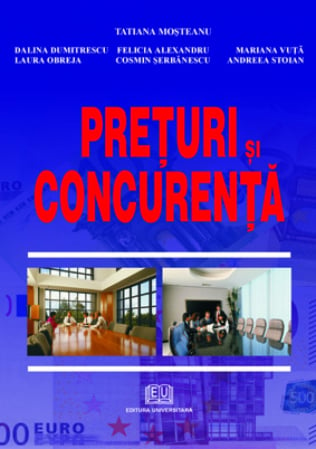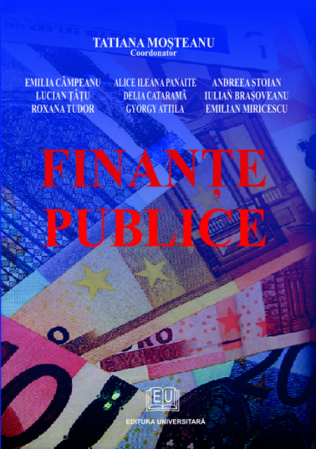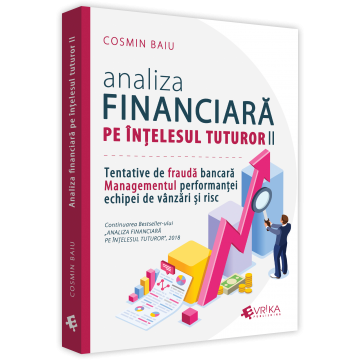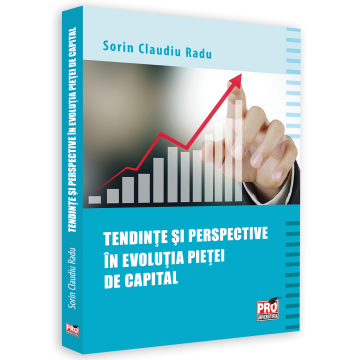Manuscript proposals: info@editurauniversitara.ro / 0745 204 115 //// Tracking orders Individuals / Sales:0745 200 718 / 0745 200 357 Orders Legal entities: 0721 722 783
Publisher: Editura Universitara
Author: Radu Despa, Daniela Zirra, Alina Avrigeanu, Andreea-Clara Munteanu, Mihai Nedelescu
ISBN: 978-973-749-850-2
Publisher year: 2010
Edition: I
Pages: 358
Product Code:
9789737498502
Do you need help?
0745 200 718
/
0745 200 357
- Description
- Download (1)
- Authors
- Content
- More details
- Where to find it
- Reviews (0)
The investments constitute the foundation of the future development of the companies, having a decisive role in the supplementation, diversification and qualitative increase of all the production factors, ensuring the improvement of the competitive position in relation to other economic agents. At the same time, investments are the material support of economic growth and development, contributing to ensuring the normal functioning of the economy, increasing the production apparatus and material support of socio-cultural activities, as well as increasing the living standards of the population.
In general, investments represent capital investments made in order to obtain profitable income in the future. In this sense, we refer to financial investments, which include the acquisition of securities in order to obtain dividends, the placement of financial availabilities in banks for interest or the spending of sums of money for starting businesses, in order to achieve profits.
In a narrow sense, investments represent capital expenditures made in order to obtain durable goods through which, in the future, profitable income will be obtained. This category of investments is represented by the capital investments that represent the expenses made in order to create or acquire fixed, productive and unproductive capital elements,
as well as for the modernization, development and refurbishment of the fixed capital existing at a given moment within the company. Capital investments constitute the material support of economic growth and the development of socio-cultural activities, through them ensuring the increase of companies' capital, increasing the number of jobs, diversifying production, increasing labor productivity and equipment efficiency, etc.
In economic theory and practice there are various approaches to defining investments. Thus, from an accounting point of view, investments are defined by reference to their material side, respectively the increases of amounts allocated in fixed assets and net current assets, created within the company or acquired, intended or not for the current activity. In this vision, the emphasis is usually on the first category of investments, the one in fixed assets, in the calculations being present the amortization defined as a means of recovery of the investment.
From a financial point of view, the content of the notion of investment is the exchange between the currently available capital, certain and the hope of collecting in the future a flow of amounts, a larger and more important capital. In this vision, investments are the amounts allocated at present, from which results are expected (in terms of economic growth of the company) in the future and which are amortized over a longer period of time.
From an economic point of view, investments represent the renunciation of the immediate use of available resources, in order to obtain higher or more important future incomes compared to the costs incurred. It is anticipated that on the basis of investments to obtain benefits and useful effects of various nature, over several years.
In general, investments represent capital investments made in order to obtain profitable income in the future. In this sense, we refer to financial investments, which include the acquisition of securities in order to obtain dividends, the placement of financial availabilities in banks for interest or the spending of sums of money for starting businesses, in order to achieve profits.
In a narrow sense, investments represent capital expenditures made in order to obtain durable goods through which, in the future, profitable income will be obtained. This category of investments is represented by the capital investments that represent the expenses made in order to create or acquire fixed, productive and unproductive capital elements,
as well as for the modernization, development and refurbishment of the fixed capital existing at a given moment within the company. Capital investments constitute the material support of economic growth and the development of socio-cultural activities, through them ensuring the increase of companies' capital, increasing the number of jobs, diversifying production, increasing labor productivity and equipment efficiency, etc.
In economic theory and practice there are various approaches to defining investments. Thus, from an accounting point of view, investments are defined by reference to their material side, respectively the increases of amounts allocated in fixed assets and net current assets, created within the company or acquired, intended or not for the current activity. In this vision, the emphasis is usually on the first category of investments, the one in fixed assets, in the calculations being present the amortization defined as a means of recovery of the investment.
From a financial point of view, the content of the notion of investment is the exchange between the currently available capital, certain and the hope of collecting in the future a flow of amounts, a larger and more important capital. In this vision, investments are the amounts allocated at present, from which results are expected (in terms of economic growth of the company) in the future and which are amortized over a longer period of time.
From an economic point of view, investments represent the renunciation of the immediate use of available resources, in order to obtain higher or more important future incomes compared to the costs incurred. It is anticipated that on the basis of investments to obtain benefits and useful effects of various nature, over several years.
-
Eficienţa investiţiilor
Download
RADU DESPA
DANIELA ZIRRA
ALINA AVRIGEANU
ANDREEA-CLARA MUNTEANU
MIHAI NEDELESCU
DANIELA ZIRRA
ALINA AVRIGEANU
ANDREEA-CLARA MUNTEANU
MIHAI NEDELESCU
I. GENERAL NOTIONS REGARDING INVESTMENTS / 7
1. The concept of investments / 8
2. The place and role of investments in the market economy / 14
3. Investment decision / 15
4. Sources of investment financing / 18
5. Investment risk / 25
II. CONCEPTUAL BOUNDARIES REGARDING INVESTMENT EFFICIENCY / 33
1. The concept of economic efficiency / 34
2. The characteristics of the economic efficiency of investments / 38
3. Principles, indicators and criteria of economic efficiency of investments / 41
III. THE INFLUENCE OF THE TIME FACTOR ON THE EFFICIENCY OF INVESTMENT PROJECTS / 51
1. The essence and forms of manifestation of the time factor in investments. Project life cycle / 52
2. Dynamic approach to evaluating the efficiency of investment projects / 69
3. Evaluation of the effects of capital immobilization during the realization of the investment / 73
IV. UPDATE - BASIC ELEMENT OF THE INVESTMENT DECISION / 83
1. Methodological aspects regarding the update / 84
2. Reference moments used in the update technique / 88
3. Calculation formulas used in the updating technique / 89
4. Invariance of economic efficiency indicators regardless of the time of update / 100
5. Update rate (a) and how to set it / 101
V. INVESTMENT EFFICIENCY ASSESSMENT INDICATORS / 105
1. Static indicators for assessing investment projects / 106
2. Practical applications regarding static indicators / 113
3. Dynamic indicators for assessing investment projects / 122
4. Practical applications regarding dynamic indicators / 130
VI. OPTIMIZING THE USE OF RESOURCES FOR INVESTMENTS / 159
1. General considerations / 160
2. Optimization of investment decisions through the linear programming method / 162
3. Optimization of investment decisions through the dynamic programming method / 167
VII. ECO-EFFICIENCY OF INVESTMENTS / 189
1. Conceptual clarifications / 190
2. Indicators for measuring eco-efficiency. Building the sustainability report of the company / 195
3. Elements of substantiation of the investment decision / 198
VIII. FINANCIAL PLANNING AND DIAGNOSIS OF INVESTMENT PROJECTS / 203
1. Purpose, functions and objectives of the financial forecast / 204
2. Forms and instruments of financial forecasting / 207
3. Financing plan for investment projects / 210
IX. BUSINESS PLAN AND USE IN THE PRACTICAL ACTIVITY OF THE PRINCIPLES AND CRITERIA OF ECONOMIC EFFICIENCY / 215
1. The importance and necessity of drawing up the business plan / 216
2. Definition and typology of business plans / 220
3. Content of the business plan / 224
4. Business plan versus feasibility study / 247
X. FEASIBILITY STUDY / 251
1. The importance and necessity of drawing up the feasibility study / 252
2. Definition and typology of feasibility studies / 256
3. Content of the feasibility study / 258
XI. EFFICIENCY OF FOREIGN DIRECT INVESTMENTS / 287
1. Definition and typology of Foreign Direct Investments (FDI) / 289
2. Theories and models of Foreign Direct Investment (FDI) / 298
3. Valuation of Foreign Direct Investment (FDI) / 310
XII. EFFICIENCY OF TECHNOLOGY TRANSFER / 327
1. General considerations regarding the evaluation of the economic efficiency of the technology transfer / 328
2. Evaluating the efficiency of technology transfer / 331
XIII. CHECKING GRIDS / 339
BIBLIOGRAPHY / 357
1. The concept of investments / 8
2. The place and role of investments in the market economy / 14
3. Investment decision / 15
4. Sources of investment financing / 18
5. Investment risk / 25
II. CONCEPTUAL BOUNDARIES REGARDING INVESTMENT EFFICIENCY / 33
1. The concept of economic efficiency / 34
2. The characteristics of the economic efficiency of investments / 38
3. Principles, indicators and criteria of economic efficiency of investments / 41
III. THE INFLUENCE OF THE TIME FACTOR ON THE EFFICIENCY OF INVESTMENT PROJECTS / 51
1. The essence and forms of manifestation of the time factor in investments. Project life cycle / 52
2. Dynamic approach to evaluating the efficiency of investment projects / 69
3. Evaluation of the effects of capital immobilization during the realization of the investment / 73
IV. UPDATE - BASIC ELEMENT OF THE INVESTMENT DECISION / 83
1. Methodological aspects regarding the update / 84
2. Reference moments used in the update technique / 88
3. Calculation formulas used in the updating technique / 89
4. Invariance of economic efficiency indicators regardless of the time of update / 100
5. Update rate (a) and how to set it / 101
V. INVESTMENT EFFICIENCY ASSESSMENT INDICATORS / 105
1. Static indicators for assessing investment projects / 106
2. Practical applications regarding static indicators / 113
3. Dynamic indicators for assessing investment projects / 122
4. Practical applications regarding dynamic indicators / 130
VI. OPTIMIZING THE USE OF RESOURCES FOR INVESTMENTS / 159
1. General considerations / 160
2. Optimization of investment decisions through the linear programming method / 162
3. Optimization of investment decisions through the dynamic programming method / 167
VII. ECO-EFFICIENCY OF INVESTMENTS / 189
1. Conceptual clarifications / 190
2. Indicators for measuring eco-efficiency. Building the sustainability report of the company / 195
3. Elements of substantiation of the investment decision / 198
VIII. FINANCIAL PLANNING AND DIAGNOSIS OF INVESTMENT PROJECTS / 203
1. Purpose, functions and objectives of the financial forecast / 204
2. Forms and instruments of financial forecasting / 207
3. Financing plan for investment projects / 210
IX. BUSINESS PLAN AND USE IN THE PRACTICAL ACTIVITY OF THE PRINCIPLES AND CRITERIA OF ECONOMIC EFFICIENCY / 215
1. The importance and necessity of drawing up the business plan / 216
2. Definition and typology of business plans / 220
3. Content of the business plan / 224
4. Business plan versus feasibility study / 247
X. FEASIBILITY STUDY / 251
1. The importance and necessity of drawing up the feasibility study / 252
2. Definition and typology of feasibility studies / 256
3. Content of the feasibility study / 258
XI. EFFICIENCY OF FOREIGN DIRECT INVESTMENTS / 287
1. Definition and typology of Foreign Direct Investments (FDI) / 289
2. Theories and models of Foreign Direct Investment (FDI) / 298
3. Valuation of Foreign Direct Investment (FDI) / 310
XII. EFFICIENCY OF TECHNOLOGY TRANSFER / 327
1. General considerations regarding the evaluation of the economic efficiency of the technology transfer / 328
2. Evaluating the efficiency of technology transfer / 331
XIII. CHECKING GRIDS / 339
BIBLIOGRAPHY / 357
The investments constitute the foundation of the future development of the companies, having a decisive role in the supplementation, diversification and qualitative increase of all the production factors, ensuring the improvement of the competitive position in relation to other economic agents. At the same time, investments are the material support of economic growth and development, contributing to ensuring the normal functioning of the economy, increasing the production apparatus and material support of socio-cultural activities, as well as increasing the living standards of the population.
In general, investments represent capital investments made in order to obtain profitable income in the future. In this sense, we refer to financial investments, which include the acquisition of securities in order to obtain dividends, the placement of financial availabilities in banks for interest or the spending of sums of money for starting businesses, in order to achieve profits.
In a narrow sense, investments represent capital expenditures made in order to obtain durable goods through which, in the future, profitable income will be obtained. This category of investments is represented by the capital investments that represent the expenses made in order to create or acquire fixed, productive and unproductive capital elements,
as well as for the modernization, development and refurbishment of the fixed capital existing at a given moment within the company. Capital investments constitute the material support of economic growth and the development of socio-cultural activities, through them ensuring the increase of companies' capital, increasing the number of jobs, diversifying production, increasing labor productivity and equipment efficiency, etc.
In economic theory and practice there are various approaches to defining investments. Thus, from an accounting point of view, investments are defined by reference to their material side, respectively the increases of amounts allocated in fixed assets and net current assets, created within the company or acquired, intended or not for the current activity. In this vision, the emphasis is usually on the first category of investments, the one in fixed assets, in the calculations being present the amortization defined as a means of recovery of the investment.
From a financial point of view, the content of the notion of investment is the exchange between the currently available capital, certain and the hope of collecting in the future a flow of amounts, a larger and more important capital. In this vision, investments are the amounts allocated at present, from which results are expected (in terms of economic growth of the company) in the future and which are amortized over a longer period of time.
From an economic point of view, investments represent the renunciation of the immediate use of available resources, in order to obtain higher or more important future incomes compared to the costs incurred. It is anticipated that on the basis of investments to obtain benefits and useful effects of various nature, over several years.
The investments present a series of characteristics that offer them a special status in all the expenses of the economic agents, the most representative being:
- investments are certain expenses, are currently made and are often irreversible;
- the incomes and benefits, which are realized after the completion of the investments, respectively in the future, are uncertain and subject to risks;
- the investment effort is often very complex, involving material, financial and human resources that materialize in investment objectives;
- the investments materialize in durable goods, with high value, on account of which it is anticipated to obtain long-term results;
- the investment resources remain immobilized until the completion of the investment or until the moment of starting the generation of the expected benefits;
- the investment process is risky, both during the realization of the investment and during the functioning of the investment objective;
- the decision to make the investment involves a careful analysis of the company's potential and the business environment;
- the realization of investments is decisively affected by the influence of the time factor;
- the investment process is closely interdependent with all segments of economic and social life and in correlation with economic growth.
The financial manager considers the investment as a capital immobilization decision in order to obtain a good return in the future. Its main role is to find the necessary sources of financing for investments, to evaluate and obtain an appropriate return.
The financial manager must compare the initial investment with the revenues it will generate in the future and accept that variant of investment whose profitability is higher than the cost of financing and which brings appropriate cash flows in the shortest possible time.
Investments can be classified from several points of view:
1) by the “nationality” of the invested capital:
a) domestic investments, with Romanian capital;
b) foreign investments, with foreign capital;
c) mixed investments, with Romanian and foreign capital.
2) by source of capital:
a) investments made from own sources, which can be constituted from the own capital (from the profit, from the receipts obtained through the sale of some assets or from the amortization fund);
b) investments made from attracted sources, respectively internal and external bank loans, budgetary allocations, funds obtained through international financing programs, etc.
3) by the nature of the investments:
a) tangible investments, which materialize in elements of fixed capital and other categories of fixed and current assets consisting of the following types:
• actual investments (with priority fixed assets - buildings, machines, equipment, installations, means of transport, etc.):
- built fixed assets;
- fixed assets purchased;
- modernized fixed assets;
- fixed assets replaced.
• assimilated investments:
- explorations, prospecting, geological research related to investment works;
- design for achieving investment objectives;
- afforestation, vineyards and fruit trees, land improvement works.
- expenses with the salary and the preparation / improvement of the labor force necessary for the realization of the investments;
- site organization works;
- transport, assembly, disassembly, reassembly of fixed assets;
- change of land use;
- working capital required immediately after the commissioning of the investment objective;
- maintenance of vineyards and fruit trees until obtaining the first harvest;
b) intangible investments (for know-how):
• research and development activity to attract customers (potential customers), which in no more than 5 years will ensure the "commercial success" of the company;
• creating, maintaining and ensuring the logistics of commercial networks;
• computer programs (created or purchased);
• staff training and development;
• performing economic-financial and management-marketing analyzes, studies and diagnoses.
c) financial or portfolio investments (long-term capital investments):
• purchase of receivables;
• acquisition of securities (shares, bonds, government securities).
4) by object of investments:
a) investments to replace the morally and / or physically used fixed capital;
b) investments to modernize and increase productivity;
c) investments for expansion or economic growth through extension, development or construction of new objectives;
d) investments of innovation and scientific research, made in order to increase the competitive capacity of the company by reducing operating costs, developing new products and technologies, etc .;
e) strategic investments, which can be:
• offensive, carried out with the aim of:
- strengthening the market position;
- growth of the market segment;
- entering new markets;
- remaining in the technological vanguard.
• defensive, made in order to:
- maintaining the position on the market;
- protection against the emergence of new competitors, etc.
5) by degree of risk:
a) investments with a minimum degree of risk (strategic investments, of national importance, made with the state guarantee, such as the construction of highways, nuclear power plants, hydroelectric power plants, etc.);
b) investments with a low degree of risk (characterized by a short duration of capital recovery (2-3 years), small size, such as investments to replace used equipment, etc.);
c) investments with a moderate or medium degree of risk (modernization, development, refurbishment without changing the market, etc., which is characterized by a capital recovery period of 3-4 years);
d) investments with a high degree of risk (which involve significant costs and can be intended to change the manufacturing profile or increase production capacity by more than 50%, the life of the investment objective is over 25 years and the capital recovery time of 6-7 years);
e) investments with a very high degree of risk (projects based on new technical solutions, launching new products, whose results are uncertain, etc.).
6) according to the destination of the investment objective:
a) productive investments, materialized in investment objectives that are to be used for a longer period of time as a working tool in the basic activity of the company;
b) unproductive investments, made to increase safety at work, to achieve social objectives or to buy goods for speculative purposes.
7) according to the relationship with the main investment objective:
a) direct investments, destined to the effective achievement of the main objective;
b) related investments, destined to the branches or domains located upstream or downstream from the main objective (supply of raw materials or creation of communication routes and distribution networks);
c) collateral investments, destined to the realization of the annex constructions, of the internal communication networks, to the assurance of the utilities and the realization of the necessary infrastructure for the good functioning of the basic objective.
8) according to the manner of constitution:
a) net investments, consisting of funds from the net national product, with the aim of increasing the fixed capital and stocks of raw materials and materials;
b) gross investments, consisting of net investments plus depreciation whose main purpose is the replacement of spent fixed capital.
In general, investments represent capital investments made in order to obtain profitable income in the future. In this sense, we refer to financial investments, which include the acquisition of securities in order to obtain dividends, the placement of financial availabilities in banks for interest or the spending of sums of money for starting businesses, in order to achieve profits.
In a narrow sense, investments represent capital expenditures made in order to obtain durable goods through which, in the future, profitable income will be obtained. This category of investments is represented by the capital investments that represent the expenses made in order to create or acquire fixed, productive and unproductive capital elements,
as well as for the modernization, development and refurbishment of the fixed capital existing at a given moment within the company. Capital investments constitute the material support of economic growth and the development of socio-cultural activities, through them ensuring the increase of companies' capital, increasing the number of jobs, diversifying production, increasing labor productivity and equipment efficiency, etc.
In economic theory and practice there are various approaches to defining investments. Thus, from an accounting point of view, investments are defined by reference to their material side, respectively the increases of amounts allocated in fixed assets and net current assets, created within the company or acquired, intended or not for the current activity. In this vision, the emphasis is usually on the first category of investments, the one in fixed assets, in the calculations being present the amortization defined as a means of recovery of the investment.
From a financial point of view, the content of the notion of investment is the exchange between the currently available capital, certain and the hope of collecting in the future a flow of amounts, a larger and more important capital. In this vision, investments are the amounts allocated at present, from which results are expected (in terms of economic growth of the company) in the future and which are amortized over a longer period of time.
From an economic point of view, investments represent the renunciation of the immediate use of available resources, in order to obtain higher or more important future incomes compared to the costs incurred. It is anticipated that on the basis of investments to obtain benefits and useful effects of various nature, over several years.
The investments present a series of characteristics that offer them a special status in all the expenses of the economic agents, the most representative being:
- investments are certain expenses, are currently made and are often irreversible;
- the incomes and benefits, which are realized after the completion of the investments, respectively in the future, are uncertain and subject to risks;
- the investment effort is often very complex, involving material, financial and human resources that materialize in investment objectives;
- the investments materialize in durable goods, with high value, on account of which it is anticipated to obtain long-term results;
- the investment resources remain immobilized until the completion of the investment or until the moment of starting the generation of the expected benefits;
- the investment process is risky, both during the realization of the investment and during the functioning of the investment objective;
- the decision to make the investment involves a careful analysis of the company's potential and the business environment;
- the realization of investments is decisively affected by the influence of the time factor;
- the investment process is closely interdependent with all segments of economic and social life and in correlation with economic growth.
The financial manager considers the investment as a capital immobilization decision in order to obtain a good return in the future. Its main role is to find the necessary sources of financing for investments, to evaluate and obtain an appropriate return.
The financial manager must compare the initial investment with the revenues it will generate in the future and accept that variant of investment whose profitability is higher than the cost of financing and which brings appropriate cash flows in the shortest possible time.
Investments can be classified from several points of view:
1) by the “nationality” of the invested capital:
a) domestic investments, with Romanian capital;
b) foreign investments, with foreign capital;
c) mixed investments, with Romanian and foreign capital.
2) by source of capital:
a) investments made from own sources, which can be constituted from the own capital (from the profit, from the receipts obtained through the sale of some assets or from the amortization fund);
b) investments made from attracted sources, respectively internal and external bank loans, budgetary allocations, funds obtained through international financing programs, etc.
3) by the nature of the investments:
a) tangible investments, which materialize in elements of fixed capital and other categories of fixed and current assets consisting of the following types:
• actual investments (with priority fixed assets - buildings, machines, equipment, installations, means of transport, etc.):
- built fixed assets;
- fixed assets purchased;
- modernized fixed assets;
- fixed assets replaced.
• assimilated investments:
- explorations, prospecting, geological research related to investment works;
- design for achieving investment objectives;
- afforestation, vineyards and fruit trees, land improvement works.
- expenses with the salary and the preparation / improvement of the labor force necessary for the realization of the investments;
- site organization works;
- transport, assembly, disassembly, reassembly of fixed assets;
- change of land use;
- working capital required immediately after the commissioning of the investment objective;
- maintenance of vineyards and fruit trees until obtaining the first harvest;
b) intangible investments (for know-how):
• research and development activity to attract customers (potential customers), which in no more than 5 years will ensure the "commercial success" of the company;
• creating, maintaining and ensuring the logistics of commercial networks;
• computer programs (created or purchased);
• staff training and development;
• performing economic-financial and management-marketing analyzes, studies and diagnoses.
c) financial or portfolio investments (long-term capital investments):
• purchase of receivables;
• acquisition of securities (shares, bonds, government securities).
4) by object of investments:
a) investments to replace the morally and / or physically used fixed capital;
b) investments to modernize and increase productivity;
c) investments for expansion or economic growth through extension, development or construction of new objectives;
d) investments of innovation and scientific research, made in order to increase the competitive capacity of the company by reducing operating costs, developing new products and technologies, etc .;
e) strategic investments, which can be:
• offensive, carried out with the aim of:
- strengthening the market position;
- growth of the market segment;
- entering new markets;
- remaining in the technological vanguard.
• defensive, made in order to:
- maintaining the position on the market;
- protection against the emergence of new competitors, etc.
5) by degree of risk:
a) investments with a minimum degree of risk (strategic investments, of national importance, made with the state guarantee, such as the construction of highways, nuclear power plants, hydroelectric power plants, etc.);
b) investments with a low degree of risk (characterized by a short duration of capital recovery (2-3 years), small size, such as investments to replace used equipment, etc.);
c) investments with a moderate or medium degree of risk (modernization, development, refurbishment without changing the market, etc., which is characterized by a capital recovery period of 3-4 years);
d) investments with a high degree of risk (which involve significant costs and can be intended to change the manufacturing profile or increase production capacity by more than 50%, the life of the investment objective is over 25 years and the capital recovery time of 6-7 years);
e) investments with a very high degree of risk (projects based on new technical solutions, launching new products, whose results are uncertain, etc.).
6) according to the destination of the investment objective:
a) productive investments, materialized in investment objectives that are to be used for a longer period of time as a working tool in the basic activity of the company;
b) unproductive investments, made to increase safety at work, to achieve social objectives or to buy goods for speculative purposes.
7) according to the relationship with the main investment objective:
a) direct investments, destined to the effective achievement of the main objective;
b) related investments, destined to the branches or domains located upstream or downstream from the main objective (supply of raw materials or creation of communication routes and distribution networks);
c) collateral investments, destined to the realization of the annex constructions, of the internal communication networks, to the assurance of the utilities and the realization of the necessary infrastructure for the good functioning of the basic objective.
8) according to the manner of constitution:
a) net investments, consisting of funds from the net national product, with the aim of increasing the fixed capital and stocks of raw materials and materials;
b) gross investments, consisting of net investments plus depreciation whose main purpose is the replacement of spent fixed capital.
www.editurauniversitara.ro
If you want to express your opinion about this product you can add a review.
write a review
Customer Support Monday - Friday, between 8.00 - 16.00
0745 200 718 0745 200 357 comenzi@editurauniversitara.ro
6359.png)
![Investment Efficiency [1] Investment Efficiency [1]](https://gomagcdn.ro/domains/editurauniversitara.ro/files/product/large/eficiena-investiiilor-2317-265544.jpg)


